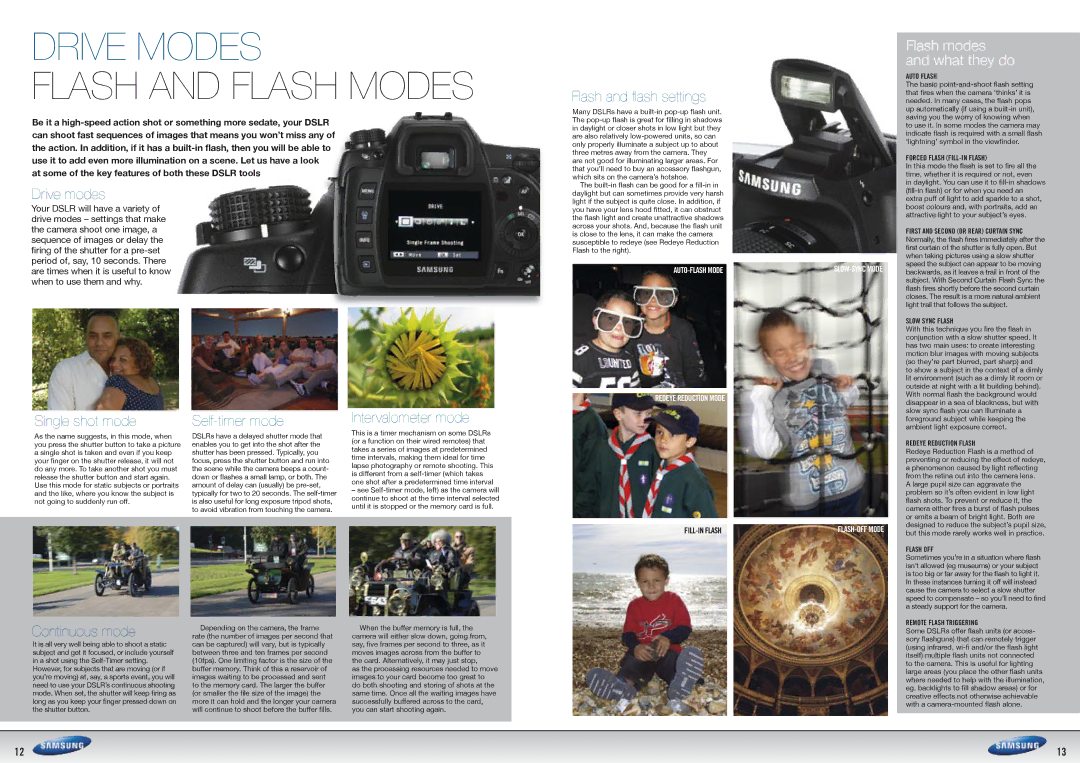
DRIVE MODES
FLASH AND FLASH MODES
Be it a
Drive modes
Your DSLR will have a variety of drive modes – settings that make the camera shoot one image, a sequence of images or delay the
firing of the shutter for a
Flash and fl ash settings
Many DSLRs have a
The
REDEYE REDUCTION MODE
Flash modes and what they do
AUTO FLASH
The basic
FORCED FLASH (FILL-IN FLASH)
In this mode the fl ash is set to fi re all the time, whether it is required or not, even
in daylight. You can use it to fi
FIRST AND SECOND (OR REAR) CURTAIN SYNC Normally, the flash fires immediately after the first curtain of the shutter is fully open. But when taking pictures using a slow shutter speed the subject can appear to be moving backwards, as it leaves a trail in front of the subject. With Second Curtain Flash Sync the flash fires shortly before the second curtain closes. The result is a more natural ambient light trail that follows the subject.
SLOW SYNC FLASH
With this technique you fi re the fl ash in conjunction with a slow shutter speed. It has two main uses: to create interesting motion blur images with moving subjects (so they’re part blurred, part sharp) and to show a subject in the context of a dimly lit environment (such as a dimly lit room or outside at night with a lit building behind). With normal fl ash the background would disappear in a sea of blackness, but with
Single shot mode
As the name suggests, in this mode, when you press the shutter button to take a picture a single shot is taken and even if you keep your fi nger on the shutter release, it will not do any more. To take another shot you must release the shutter button and start again. Use this mode for static subjects or portraits and the like, where you know the subject is not going to suddenly run off.
Continuous mode
It is all very well being able to shoot a static subject and get it focused, or include yourself in a shot using the
Self-timer mode
DSLRs have a delayed shutter mode that enables you to get into the shot after the shutter has been pressed. Typically, you focus, press the shutter button and run into the scene while the camera beeps a count- down or fl ashes a small lamp, or both. The amount of delay can (usually) be
Depending on the camera, the frame rate (the number of images per second that can be captured) will vary, but is typically between three and ten frames per second (10fps). One limiting factor is the size of the buffer memory. Think of this a reservoir of images waiting to be processed and sent to the memory card. The larger the buffer (or smaller the fi le size of the image) the more it can hold and the longer your camera will continue to shoot before the buffer fi lls.
Intervalometer mode
This is a timer mechanism on some DSLRs (or a function on their wired remotes) that takes a series of images at predetermined time intervals, making them ideal for time lapse photography or remote shooting. This is different from a
–see
When the buffer memory is full, the camera will either slow down, going from, say, fi ve frames per second to three, as it moves images across from the buffer to the card. Alternatively, it may just stop,
as the processing resources needed to move images to your card become too great to do both shooting and storing of shots at the same time. Once all the waiting images have successfully buffered across to the card, you can start shooting again.
FLASH-OFF MODE
slow sync fl ash you can illuminate a foreground subject while keeping the ambient light exposure correct.
REDEYE REDUCTION FLASH
Redeye Reduction Flash is a method of preventing or reducing the effect of redeye, a phenomenon caused by light refl ecting from the retina out into the camera lens.
A large pupil size can aggravate the problem so it’s often evident in low light
flash shots. To prevent or reduce it, the camera either fi res a burst of fl ash pulses or emits a beam of bright light. Both are designed to reduce the subject’s pupil size, but this mode rarely works well in practice.
FLASH OFF
Sometimes you’re in a situation where flash isn’t allowed (eg museums) or your subject is too big or far away for the flash to light it. In these instances turning it off will instead cause the camera to select a slow shutter speed to compensate – so you’ll need to find a steady support for the camera.
REMOTE FLASH TRIGGERING
Some DSLRs offer fl ash units (or acces- sory fl ashguns) that can remotely trigger (using infrared,
12 | 13 |
